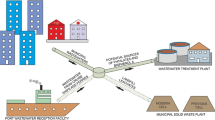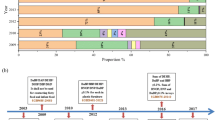Abstract
Due to their pervasive applications, phthalic acid esters or phthalates have ample presence in all environmental compartments. A principal source of their existence in freshwater is phthalate-laden wastewater treatment plant effluents. For its sustainable operation and biogas production, wastewater treatment scheme of up flow anaerobic sludge blanket (UASB) and polishing pond is more prevalent in developing countries. This yearlong study focused on evaluating the occurrence, fate and risk of four priority phthalates, diethyl phthalate (DEP), dibutyl phthalate (DBP), benzylbutyl phthalate (BBP), and diethylhexyl phthalate (DEHP) in a UASB+ polishing pond-based wastewater treatment plant. Concentration of the phthalates in raw wastewater ranged from nd to 17.36 μg/L (DEP), 0.92 to 18.26 μg/L (DBP), nd to 6.54 μg/L (BBP), and nd to 53.21 μg/L (DEHP). DEHP concentrations in UASB sludge were below 100 mg/kg, the recommended limit by the European Union for safe disposal of dewatered sludge. All four compounds were removed approximately 80% in the wastewater treatment plant, with larger removal in polishing pond than UASB. Sorption contributes a significant portion of BBP and DEHP removal (15–24%) in UASB than DEP and DBP (0–3%). Seasonally, larger removals of phthalates were observed during the summer season. Risk assessment showed that the treated effluents had low risk of DEP, DBP, and BBP. However, the hazard quotient (HQ) of DEHP was greater than 1. To comply with regulations, dilution requirement of effluents was investigated which showed that a dilution factor of 4.4 in summer and 2.1 in winter is required for effluents of UASB + Pond-based treatment plant.




Similar content being viewed by others
References
Alvarino T, Suarez S, Garrido M, Lema JM, Omil F (2015) A UASB reactor coupled to a hybrid aerobic MBR as innovative plant configuration to enhance the removal of organic micropollutants. Chemosphere 144:452–458
APHA (2005) “Standard methods for the examination of water and wastewater”
Balabanic D, Hermosilla D, Merayo N, Klemenčič AK, Blanco Á (2012) Comparison of different wastewater treatments for removal of selected endocrine-disruptors from paper mill wastewaters. J Environ Sci Health A 47(10):1350–1363
Boonyaroj V, Chiemchaisri C, Chiemchaisri W, Theepharaksapan S, Yamamoto K (2012) Toxic organic micro-pollutants removal mechanisms in long-term operated membrane bioreactor treating municipal solid waste leachate. Bioresour Technol 113:174–180
Brandt EM, de Queiroz FB, Afonso RJ, Aquino SF, Chernicharo CA (2013) Behavior of pharmaceuticals and endocrine disrupting chemicals in simplified sewage treatment systems. J Environ Manag 128:718–726
Cadogan DF, Papez M, Popp¢ AC, Scheubel J (1993) An assessment of the release, occurrence and possible effect of plasticizers in the environment. Prog Rubber Plast Recycl Technol 10(1):1–19
Calley D, Autian J, Guess WL (1966) Toxicology of a series of phthalate esters. J Pharm Sci 55(2):158–162
Chernicharo CAL, Aquino SF, von Sperling M, Stuetz RM, Santos LV, Mabub MOA, Moreira MA, Vasconcelos OMSR, Glória RM (2010) Conceptual analysis of the UASB/polishing pond system regarding the removal of specific constituents and control of gaseous emissions. Water Sci Technol 61(5):1211–1219
Central Inland Fisheries Research Institute (CIFRI) (2014) The ecology and fishery status of river Yamuna. Bulletin No 184
Clara M, Windhofer G, Hartl W, Braun K, Simon M, Gans O, Scheffknecht C, Chovanec A (2010) Occurrence of phthalates in surface runoff, untreated and treated wastewater and fate during wastewater treatment. Chemosphere 78:1078–1084
CPCB (Central Pollution Control Board) (2003) “Status of sewage treatment plants in Ganga Basin.” Central Pollution Control Board, Delhi
CPHEEO (2012) “Manual on sewerage and sewage treatment, part A: engineering final draft. Central public health and environmental engineering organization,” Ministry of Urban Development, New Delhi
CPSC (2010) Review of Exposure and Toxicity Data for Phthalate Substitutes. Consumer Product Safety Commisssion: Bethesda, MD
Dargnat C, Teil MJ, Chevreuil M, Blanchard M (2009) Phthalate removal throughout wastewater treatment plant case study of Marne Aval station (France). Sci Total Environ 407(4):1235–1244
Das MT, Ghosh P, Thakur IS (2014) Intake estimates of phthalate esters for South Delhi population based on exposure media assessment. Environ Pollut 189:118–125
Ejlertsson J, Alnervik M, Jonsson S, Svensson BH (1997) Influence of water solubility, side-chain degradability, and side-chain structure on the degradation of phthalic acid esters under methanogenic conditions. Environ Sci Technol 31(10):2761–2764
EU (2000) Working Document on Sludge 3rd Draft. Unpublished, p. 19
EU (2013) DIRECTIVE 2013/39/EU OF THE EUROPEAN PARLIAMENT AND OF THE COUNCIL of 12 August 2013 amending Directives 2000/60/EC and 2008/105/EC as regards priority substances in the field of water policy
Fauser P, Vikelsøe J, Sørensen PB, Carlsen L (2003) Phthalates, nonylphenols and LAS in an alternately operated wastewater treatment plant—fate modelling based on measured concentrations in wastewater and sludge. Water Res 37(6):1288–1295
Gani KM, Rajpal A, Kazmi AA (2016) Contamination level of four priority phthalates in north Indian wastewater treatment plants and their fate in sequencing batch reactor systems. Environ Sci Processes Impacts 18(3):406–416
Gao D, Li Z, Wen Z, Ren N (2014) Occurrence and fate of phthalate esters in full-scale domestic wastewater treatment plants and their impact on receiving waters along the Songhua River in China. Chemosphere 95:24–32
Gill PS, Graedel TE (1983) Organic films on atmospheric aerosol particles, fog droplets, cloud droplets, rain drops and snowflakes. Rev Geophys Space Phys 21:903–920
Huang M, Li Y, Gu G (2008) The effects of hydraulic retention time and sludge retention time on the fate of di-(2-ethylhexyl) phthalate in a laboratory-scale anaerobic-anoxic-aerobic activated sludge system. Bioresour. Technol. 99:8107–8111
Huang M, Ma Y, Wang Y, Wan J, Zhang H (2010) The fate of di-n-butyl phthalate in a laboratory-scale anaerobic/anoxic/oxic wastewater treatment process. Bioresour. Technol. 101:7767–7772
ICMR (2010) “Nutrient requirements and recommended dietary allowances for Indians; a Report of the Expert Group of the Indian Council of Medical Research.” National Institute of Nutrition, Hyderabad, India. http://icmr.nic.in/final/RDA-2010.pdf
Iran BC, Teil MJ, Blanchard M, Alliot F, Chevreuil M (2015) BPA and phthalate fate in a sewage network and an elementary river of France. Influence of hydroclimatic condi- tions. Chemosphere 119:43–51
Joss A, Keller E, Alder AC, Göbel A, McArdell CS, Ternes T, Siegrist H (2005) Removal of pharmaceuticals and fragrances in biological wastewater treatment. Water Res 39(14):3139–3152
Khalil N, Sinha R, Raghav AK, Mittal AK (2008) “UASB technology for sewage treatment in India: experience, economic evaluation and its potential in other developing countries.” In Twelfth International Water Technology Conference (pp. 1411–1427)
Kimber I, Dearman RJ (2010) An assessment of the ability of phthalates to influence immune and allergic responses. Toxicology. 271(3):73–82
Liang DW, Zhang T, Fang HH (2007) Anaerobic degradation of dimethyl phthalate in wastewater in a UASB reactor. Water Res 41(13):2879–2884
Madsen PL, Thyme JB, Henriksen K, Møldrup P, Roslev P (1999) Kinetics of di-(2-ethylhexyl) phthalate mineralization in sludge-amended soil. Environ Sci Technol 33(15):2601–2606
Marttinen SK, Kettunen RH, Sormunen KM, Rintala JA (2003) “Removal of bis (2-ethylhexyl) phthalate at a sewage treatment plant” 37, 1385–1393
Matamoros V, Salvadó V (2012) Evaluation of the seasonal performance of a water reclamation pond-constructed wetland system for removing emerging contaminants. Chemosphere 86:111–117
Matamoros V, Rodríguez Y, Albaigés J (2016) A comparative assessment of intensive and extensive wastewater treatment technologies for removing emerging contaminants in small communities. Water Res 88:777–785
Mungray AK, Kumar P (2008) Fate of anionic surfactants in a 38 ML/day UASB-based municipal wastewater treatment plant : case study. J Environ Eng 134:1014–1022
Net S, Sempéré R, Delmont A, Paluselli A, Ouddane B (2015) Occurrence, fate, behavior and ecotoxicological state of phthalates in different environmental matrices. Environ Sci Technol 49:4019–4035
Oliver R, May E, Williams J (2005) The occurrence and removal of phthalates in a trickle filter STW. Water Res 39:4436–4444
Reyes-Contreras C, Matamoros V, Ruiz I, Soto M, Bayona JM (2011) Evaluation of PPCPs removal in a combined anaerobic digester-constructed wetland pilot plant treating urban wastewater. Chemosphere 84(9):1200–1207
Rose RJ, Priston MJ, Rigby-Jones AE, Sneyd JR (2012) The effect of temperature on di (2-ethylhexyl) phthalate leaching from PVC infusion sets exposed to lipid emulsions. Anaesthesia 67(5):514–520
Roslev P, Vorkamp K, Aarup J, Frederiksen K, Nielsen PH (2007) Degradation of phthalate esters in an activated sludge wastewater treatment plant. Water Res 41(5):969–976
Salazar V, Castillo C, Ariznavarreta C, Campón R, Tresguerres JA (2004) Effect of oral intake of dibutyl phthalate on reproductive parameters of Long Evans rats and pre-pubertal development of their offspring. Toxicology 205(1–2):131–137
Sato N, Okubo T, Onodera T, Agrawal LK, Ohashia A, Harada H (2007) Economic evaluation of sewage treatment processes in India. J Environ Manag 84:447–460
Selvaraj KK, Sundaramoorthy G, Ravichandran PK, Girijan GK, Sampath S, Ramaswamy BR (2015) Phthalate esters in water and sediments of the Kaveri River, India: environmental levels and ecotoxicological evaluations. Environ Geochem Health 37(1):83–96
Semblante GU, Hai FI, Huang X, Ball AS, Price WE, Nghiem LD (2015) Trace organic contaminants in biosolids: impact of conventional wastewater and sludge processing technologies and emerging alternatives. J Hazard Mater 300:1–17
Shi YJ, Wang XH, Qi Z, Diao MH, Gao MM, Xing SF, Wang SG, Zhao XC (2011) Sorption and biodegradation of tetracycline by nitrifying granules and the toxicity of tetracycline on granules. J Hazard Mater 191(1–3):103–109
Shneider B, Cronin J, Van Marter L, Maller E, Truog R, Jacobson M, Kevy S (1991) A prospective analysis of cholestasis in infants supported with extracorporeal membrane oxygenation. J Pediatr Gastroenterol Nutr 13(3):285–289
Simoneit BRT, Medeiros PM, Didyk BM (2005) Combustion products of plastics as indicators for refuse burning in the atmosphere. Environ Sci Technol 39:6961–6970
Tanner CC, Sukias JP (1995) Accumulation of organic solids in gravel-bed constructed wetlands. Water Sci Technol 32:229–239
Tare V, Ahammed M, Jawed M (1997) “Biomethanation in domestic and industrial waste treatment—an Indian scenario.” Proceedings of the Eighth International Conference on Anaerobic Digestion, Japan. Vol. 2, 255–262
Teil MJ, Blanchard M, Chevreuil M (2006). Atmospheric fate of phthalate esters in an urban area (Paris-France). Sci Total Environ 354(2-3):212–223
TGD, EU (2003) “Technical guidance document on risk assessment in support of commission directive 93/67/EEC on risk assessment for new notified substances, Commission Regulation (EC) No 1488/94 on Risk Assessment for existing substances, and Directive 98/8/EC of the European Parliament and of the Council concerning the placing of biocidal products on the market. Part I–IV, European Chemicals Bureau (ECB), JRC-Ispra (VA), Italy, April 2003.” Part II. European Commission Joint Research Centre. EUR, 20418
U.S. Environmental Protection Agency (1998) “Guidelines for ecological risk assessment. EPA Publication No. 630/R- 95/002F.” US Environmental Protection Agency, Washington, DC
US EPA (1990) “Integrated risk information system (IRIS): dibutyl phthalate.” Retrieved from http://www.epa.gov/iris/subst/0038.html
US EPA (2002) Method for organic chemical analysis of municipal and industrial wastewater. Method 606 —Phthalate ester; 2002
US EPA (2011) “Ecological Structure Activity Relationships (ECOSAR) Class Program, Version 1.11.” http://www.epa.gov/oppt/newchems/tools/21ecosar.htm. Accessed 29 Dec 2015
Xie Z, Ebinghaus R, Temme C, Lohmann R, Cara A, Ruck W (2007) Occurrence and air−sea exchange of phthalates in the Arctic. Environ Sci Technol 41(13):4555–4560
Zeng F, Cui K, Li X, Fu J, Sheng G (2004) Biodegradation kinetics of phthalate esters by Pseudomonas fluoresences FS1. Process Biochem 39(9):1125–1129
Funding
The corresponding author is thankful to IIT Roorkee for financial assistantship during the study.
Author information
Authors and Affiliations
Corresponding author
Additional information
Responsible editor: Philippe Garrigues
Publisher’s note
Springer Nature remains neutral with regard to jurisdictional claims in published maps and institutional affiliations.
Electronic supplementary material
ESM 1
(DOCX 9312 kb)
Rights and permissions
About this article
Cite this article
Gani, K.M., Kazmi, A.A. Ecotoxicological risk evaluation and regulatory compliance of endocrine disruptor phthalates in a sustainable wastewater treatment scheme. Environ Sci Pollut Res 27, 7785–7794 (2020). https://doi.org/10.1007/s11356-019-07418-7
Received:
Accepted:
Published:
Issue Date:
DOI: https://doi.org/10.1007/s11356-019-07418-7




